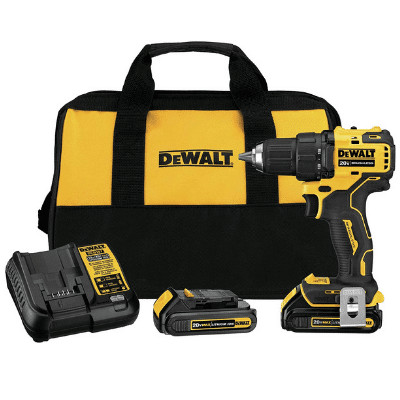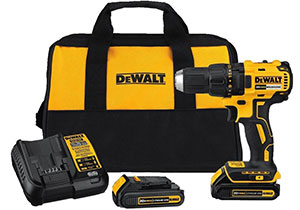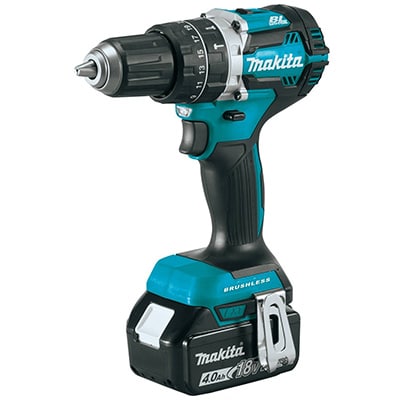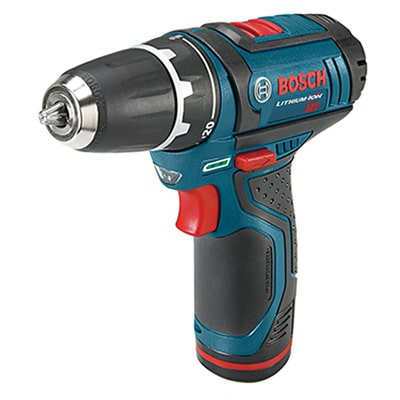Best Cordless Drill Driver — Buyers Guide, Top Pick, and Comparison
For all-around home and DIY applications — a cordless drill driver is the ultimate tool. Offering the dynamic duo of drilling and driving from one unit, these tools can bore into woods, metals, and plastics while also delivering rapid screwdriving and bolt fixing. Powered by long-life lithium-ion cells, they are as suited to cabinet making and shelf fixing as fence building and drywall slat erection. High speeds and elevated torque permit rapid completion of extensive projects, while brushless motors provide impressive energy efficiency.

- Dual speed settings.
- Driven by an 18-volt lithium-ion cell.
- Weighs just 3.4 pounds.
Cordless Drill Driver Top Picks
| IMAGE | PRODUCT | DETAILS | ||
|---|---|---|---|---|
|
Best for Speed 
|
Best for Speed
|
Makita XPH10Z
|
Features
|
Check Price at Amazon Makita XPH10Z Review Makita XPH10Z Review |
|
Best Low Profile Head 
|
Best Low Profile Head
|
DeWalt DCD708C2
|
Features
|
Check Price at Amazon Check Price at Tractor Supply DeWalt DCD708C2 Review DeWalt DCD708C2 Review |
|
Best Complete Kit 
|
Best Complete Kit
|
DeWalt DCD777C2
|
Features
|
Check Price at Amazon Check Price at Tractor Supply DeWalt DCD777C2 Review DeWalt DCD777C2 Review |
|
Best Twin Tool 
|
Best Twin Tool
|
Makita XT269M
|
Features
|
Check Price at Amazon Check Price at Tractor Supply Makita XT269M Review Makita XT269M Review |
|
Best Compact 
|
Best Compact
|
Bosch PS31-2A
|
Features
|
Check Price at Amazon Check Price at Tractor Supply Bosch PS31-2A Review Bosch PS31-2A Review |
Best Cordless Drill Driver Buying Guide
As suitable for boring into timber as they are driving screws, these versatile tools knock out speeds in excess of 1300 rpm, while offering sufficient torque to secure the hardware staples of hooks, screws, and bolts.
Ranging from basic casual use drills through to pro-grade high-efficiency units, there’s a tool for every user and application. Affordable, yet often arriving with a plethora of accessories, the majority of these machines can be used straight-outta-the-box with no additional purchases.
When selecting your ideal power driver drill, consider:
- Chuck size.
- Torque and speed output.
- Adjustable settings.
- Cell capacity.
- Inclusion of battery and charger.
- Overall weight.
- LED illumination.
- Brushless motor.
- Included accessories.
What Is a Cordless Battery Drill Driver?
Although originally developed as mains-powered units, this cord format has now become virtually extinct in the drill/driving arena. The versatility of being cordless, advancements in lithium-ion technology, and the relatively low power demands meant that the battery-powered models took the lion’s share of the market — condemning corded machines to the trash and your neighbor’s garage sale.
As a drill/boring tool, these units carry sufficient grunt to power into timbers, plastics, acrylics, ply, and soft sheet metals — meaning they’re ideal for the casual home user and light-duty tradesperson. Their main disadvantage is that they lack the brawn for masonry and concrete — applications that necessitate the use of a hammer drill.
For driving, they deliver the same convenience as an electric screwdriver — but with more rapid speeds, higher torque, and greater user tailorability. Trigger-controlled power intensity means excellent control — preventing over-driving and target material splitting. Furthermore, they typically feature speed and torque limiters, ensuring accidental finger slippages don’t ruin your projects.
Additionally, this highly controllable rotation allows the drill/driver to be operated in conjunction with a plethora of accessories — including grinding wheels, sanding points, brushes, polishers, and mixers.
Although individual models vary, rechargeable drill drivers are usually typified by:
- Compact, low-profile head.
- Driven by a single 12, 18, or 20-volt lithium-ion power cell.
- Lightweight.
- Offer drilling and driving functions.
- Throttle-controlled trigger.
- Choice of torque and speed settings.
- Keyless chucks.
- Single-handed operation.
- 0.375 or 0.5-inch chuck.
- Compatible with numerous accessories — brushes, grinders, sanders, etc.
Uses for Cordless Compact Drill Driver Machines
- Building cabinets.
- Drilling into woods, plastics, and metals.
- Fixing shelves.
- Automotive work.
- Driving bolts and screws.
- Mixing plaster.*
- Sanding.*
- Removing rust.*
- Wire intertwining.
- Attaching drywall slats.
*requires a suitable attachment
How to Choose the Best Drill Driver Set or Tool
Therefore, when deciding upon your consummate tool, it’s crucial that you think about the requirements and demands of your typical jobs — in conjunction with your own preferences.
Hence, I suggest that you consider:
Chuck
Whether you’re looking at an 18, 20, or 12v drill driver, one factor remains constant — they all include a keyless chuck.
Yet, although the choice of a keyed or keyless head is removed, you still need to consider the chuck capacity — either 0.375-inch or 0.5-inch.
Models such as the Bosch PS31-2A feature the smaller diameter version. Suitable for most standard wood and metal bits, together with driving heads, they’re perfectly acceptable for general DIYers or casual home users.
However, other machines — like the Makita XT269M — boast a behemoth 0.5-inch chuck. This increased capacity permits you to use wider diameter bits, particularly useful if you’re creating channeling in slats or joists to accommodate writing or piping.
Speed and Torque
Unfortunately, you can’t have the ultimate in both.
When picking a drill driver kit, there’s a crucial trade-off — high speed or high torque.
Those units with elevated rapidity will offer a lower amount of grunt. Conversely, machines with massive brawn may be Herculean, but at the expense of speed. Therefore, it’s vital you consider the demands of your most common projects.
Drilling or driving screws and bolts into dense hardwoods or metals requires power and control, meaning you should opt for a unit such as the Makita XT269M that provides 530 in-lbs (inch-pounds) of torque.
Conversely, if your jobs feature repetitive driving into relatively soft timbers, such as cabinet construction or fence building, go for a unit with high speed, like the 1900 rpm Makita XPH10Z.
User Controllable Settings
Always check for the number of speed and torque settings offered by the tool in question. High-end machines will typically provide two speed levels as standard — permitting you to set upper rotating velocity irrespective of how eager you are with the trigger throttle.
Furthermore, many units will boast a multitude of torque output settings — usually adjusted on the chuck clutch head — which allows you to step down or step up the machine’s grunt.
Both these features can prevent over-drilling, screwhead shearing, and timber splitting.
Battery Capacity
It’s prudent to check the mAh rating of the battery pack — which identifies how long the unit will run from a single charge. At the very least, look for a machine with a minimum of 4.0 mAh — which should provide around 45 minutes of continuous use.
Additionally, it’s wise to investigate whether the battery charger boasts a ‘quick-charge’ feature. This can allow the cell to be rapidly replenished, significantly cutting back on your downtime.
Battery and Charger Inclusion
Don’t allow your brand new, shiny drill driver to be a disappointment from the moment of unboxing.
Some units, especially the high-end examples such as the Makita XPH10Z, arrive as tool-only — that is, without an included battery or charger. Admittedly, this may not be an issue if you’re a trade contractor or semi-pro DIYer with a ready supply of rechargeable lithium-ion cells.
However, for newbies to the cordless drill driver world, it can be disheartening to find that you lack the necessary power pack to use your tool on the day of purchase. Therefore, if you don’t already own compatible chargers or cells, check that your machine arrives with these crucial components. The DeWalt DCD777C2 not only includes a charger with the tool itself, but also two lithium-ion batteries.
Weight
But be careful, manufacturer’s can be a little sneaky.
Frequently, they will boast about the lightweight nature of their machine, and indicate that it only has a few pounds of mass. What they fail to mention, is that this doesn’t include the weight of the battery too.
Hence, always dive into the detail, and check that the declared mass comprises the lithium-ion cell pack.
LED Lamp
Not essential — but can be a useful feature for a driver drill.
Requiring relatively low power, and taking up little space on the machine, an integrated LED lamp provides an additional light source for poorly lit or nighttime conditions — in many cases negating the need for a separate torch.
It’s a welcome component if your projects include working in engine bays, beneath floorboards, in attics, or inside cupboards. I would suggest, however, examining where on the tool the LED is located.
Ideally, it wants to be on the same horizontal plane as the drill bit or driving head — as exemplified by the Bosch PS31-2A — to ensure it illuminates your target area. Some maverick machines, for example, the DeWalt DCD708C2, strangely mount the lamp on the foot of the drill — which does nothing apart from lighting up the area eight inches below your target.
Brushless Motor
For me, a primary consideration.
While the internal technicalities of a drill driver may not initially seem thrilling or important, the motor design can dramatically affect the running of your chosen tool.
A brushless drill driver, perhaps unsurprisingly, utilizes an engine without brushes (instead it uses a combination of permanent and electromagnets — here’s the specifics). This prevents energy from being wasted through the heat and friction generated by brushed examples.
Although not a major issue if you’re using a mains-driven machine — although technically you’re creating a larger carbon footprint — for cordless units it affects the tools running time.
Wasted energy means a more rapidly depleting power cell — thus resulting in you having to exchange the battery frequently, or suffer the headaches of downtime while the cell recharges. Hence, whatever your projects, always opt for a brushless drill
— like the Makita XT269M.
Additional Accessories
Models vary in the additional accessories they include, and it’s beneficial to check out these add-ons to ensure you receive the greatest bang-for-your-buck.
In my opinion, the best drill driver set will include:
- Drill driver tool — duh.
- A carry case — large enough to accommodate a tool, cell, charger, and bits.
- One or more compatible lithium-ion cells.
- Battery charger.
- Mixed drill bits.
- Assorted screw and bolt driving heads.
- Brushes, grinders, sanders, and polisher attachments.
- Comprehensive warranty.
Conclusion
Affordable, flexible, and with fuss-free operation — the best cordless drill driver is the consummate all-rounder.
Excelling at home-improvement projects, their ability to switch between driving and drilling makes them ideal for the enthusiastic DIYer. Long battery running times offer welcome operational freedom, and user-adjustable torque and speed settings allow you to tailor your machine to suit your current projects.
A choice of keyless 0.375 and 0.5-inch chucks make these tools suitable for both standard screwdriving heads and wide diameter bits. Furthermore, brushless motors elongate cell life, while LED lamps provide welcome illumination for poorly lit conditions.
Sure, they’re not what you’d call hardcore. Guys looking for extreme masonry drilling tools should check out our picks of the ultimate rotary drills. Equally, those people searching for close-quarter specialist units should have a look at the best right-angle drills.
However, if you need a reliable, one-size-fits-all tool that isn’t going to break the bank — get hold of a cordless drill driver.
Best Cordless Driver Drill FAQs
Q: What Is the Best Drill Driver Combo?
In my opinion, the best cordless drill driver combo — that is, a machine that offers both boring and screw/bolt driving capabilities — is the Makita XPH10Z. Boasting 480 in-lbs or torque and incorporating a 0.5-inch chuck, it’s a powerful unit capable of handling wide diameter bits.
Q: Can You Buy a Cordless Right Angle Drill Driver
Yes. Battery-powered right-angle drill drivers allow you to operate in confined spaces while offering mains-free use. Check out our top picks of these 90-degree drills here.
Q: What Is the Difference Between Hammer Drill and Drill Driver?
A drill driver offers purely rotational bit and screwdriver head functions. A hammer drill, however, can also deliver a pummelling action in addition to the rotational feature.
Q: How Long Does the Battery on a Drill Driver Last?
A typical 4.0 mAh lithium cell will power a drill driver for around 45 minutes. However, operational time from a single charge can be affected by the density of the target material, drilling speed, and torque settings.
Q: Can I Use a Regular Drill to Drill Into Concrete?
A regular drill, typically known as a drill driver, isn’t suited for masonry work. For hardcore projects that require immense force, you need a hammer or rotary drill.
Q: Is A 20 Volt Drill Good?
Yes. A 20-volt drill will supply sufficient power for the majority of drilling and driving projects. My particular favorite is the DeWalt DCD708C2, which arrives complete with a carrying case, lithium-ion cells, and a battery charger.
